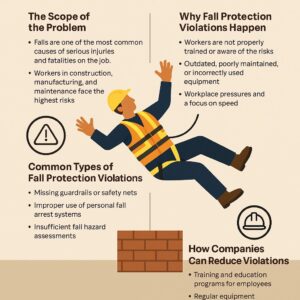Falls remain one of the leading causes of serious workplace injuries and deaths across the country. Despite clear regulations, many companies still struggle to keep their employees safe. The lawyers at Aaron Allison Law Firm often witness the consequences of ignoring fall protection rules, ranging from costly fines to devastating injuries. Understanding why these violations happen is key to preventing them and keeping workers protected. In this article, we’ll explore the reasons why fall protection remains one of OSHA’s most frequently cited violations and what can be done about it.

The Scope of the Problem
Falls are one of the most common causes of serious injuries and fatalities on the job. Workers in construction, manufacturing, and maintenance face the highest risks, often dealing with heights every day. These incidents not only put employees in danger but also create significant challenges for businesses trying to stay compliant with OSHA regulations.
Why Fall Protection Violations Happen
Many fall protection violations occur because workers are not properly trained or aware of the risks. Sometimes equipment is outdated, poorly maintained, or not used correctly, leaving employees vulnerable. Workplace pressures and a focus on speed can also lead to shortcuts that compromise safety.
Common Types of Fall Protection Violations
Falls occur in various ways, and OSHA identifies recurring violations. Here are some of the most common issues workers and employers face:
Missing Guardrails or Safety Nets
Many worksites lack proper guardrails or safety nets around elevated areas, leaving employees vulnerable to falls. Without these basic protections, even a small slip can lead to serious injury or worse.
Improper Use of Personal Fall Arrest Systems
Personal fall arrest systems are only effective when used correctly; however, mistakes can occur frequently. Workers may wear harnesses incorrectly, attach them to unsafe anchor points, or fail to inspect equipment before use.
Insufficient Fall Hazard Assessments
Some companies skip thorough assessments of potential fall hazards, underestimating the risks on-site. This oversight can result in employees working in dangerous areas without the proper safety measures in place.
Inadequate Employee Supervision and Inspections
Regular supervision and equipment inspections are critical but often neglected. Without consistent oversight, small issues can quickly escalate into significant violations and potentially hazardous situations.
The Cost of Ignoring Fall Protection
Ignoring fall protection rules can be expensive, both for businesses and employees. Here are some of the significant consequences:
Financial Impact on Businesses
Companies can face hefty OSHA fines when violations are discovered, sometimes totaling tens of thousands of dollars. Beyond fines, lawsuits, and increased insurance premiums can put a severe strain on a business’s finances.
Human Cost of Injuries
Falls can result in severe injuries, long-term disability, or even death, affecting workers and their families. The emotional toll of these accidents can linger for years, creating stress and hardship beyond the workplace.
Damage to Company Reputation
Businesses known for unsafe practices can struggle to attract new employees or clients. Negative publicity resulting from accidents or violations can erode trust and make it more challenging to maintain a strong workforce.
How Companies Can Reduce Violations
Preventing fall protection violations takes planning, commitment, and consistent effort. Here are some practical steps companies can take:
Training and Education Programs for Employees
Thorough training helps workers recognize potential hazards and understand how to use protective gear effectively. Ongoing refresher sessions reinforce safe habits, keeping safety a priority and lowering the risk of preventable mistakes.
Regular Equipment Inspection and Maintenance
Protective equipment works best when it is properly cared for and regularly checked. Setting a schedule for inspections and promptly replacing worn or broken items helps prevent accidents before they occur.
Clear Safety Protocols and Enforcement
Simple, well-defined safety guidelines clearly outline what is expected on the job site. When these rules are applied consistently, they build an environment where everyone takes responsibility for safe practices.
Fostering a Culture of Safety
Strong leadership should place safety at the center of daily operations and lead by example. When employees see that safety is valued at every level, they are more likely to treat it as an essential part of the work rather than just a requirement.
Conclusion
Fall protection remains one of OSHA’s most cited violations because the risks are real and often underestimated. The lawyers at Aaron Allison Law Firm see firsthand how ignoring these safety rules can lead to serious injuries and costly consequences. Taking proactive steps to train employees, maintain equipment, and cultivate a culture of safety can protect workers and ensure businesses remain compliant.






